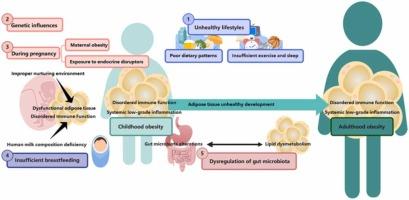Influence of adipose tissue immune dysfunction on childhood obesity |
| |
| Affiliation: | 1. Health Sciences Institute, Key Laboratory of Obesity and Glucose/Lipid Associated Metabolic Diseases, China Medical University, Shenyang 110122, Liaoning, China;2. College of Basic Medical Science, Key Laboratory of Medical Cell Biology, Ministry of Education, Key Laboratory of Liaoning Province, China Medical University, Shenyang 110122, Liaoning, China;3. Innovation Institute, China Medical University, China Medical University, Shenyang 110122, Liaoning, China;4. Department of Clinical Nutrition, Shengjing Hospital of China Medical University, Shenyang 110004, Liaoning, China;1. FaBioCell, Core Facilities, Istituto Superiore di Sanità, Rome, Italy;2. Department of Oncology and Molecular Medicine, Istituto Superiore di Sanità, Rome, Italy;3. Medical Biotechnology and Translational Medicine PhD School, II University of Rome “Tor Vergata”, Italy;4. St. Giles Laboratory of Human Genetics of Infectious Diseases, Rockefeller Branch, The Rockefeller University, New York, NY, USA;5. Laboratory of Human Genetics of Infectious Diseases, Necker Branch, INSERM U1163, Necker Hospital for Sick Children, Paris, France;6. University of Paris, Imagine Institute, Paris, France;7. Howard Hughes Medical Institute, New York, NY, USA;8. Institute of Translational Pharmacology, Consiglio Nazionale delle Ricerche, Rome, Italy;1. College of Medicine, University of Sharjah, Sharjah 27272, UAE;2. Blood and Vascular Biology Research Lab, Department of Life Sciences, Central University of Tamil Nadu, Thiruvarur 610005, India;3. Dermatology Institute, Translational Research Institute, Academic Health Systems, Hamad Medical Corporation, PO Box 3050, Doha, Qatar;4. Sharjah Institute for Medical Research, University of Sharjah, Sharjah 27272, UAE;1. Department of Oncology, San Luigi Gonzaga Hospital, University of Turin, Orbassano, Turin, Italy;2. Oncology Unit, ASST Bergamo Ovest, Treviglio, Bergamo, Italy;3. Department of Radiology, University of Cagliari, Cagliari, Italy;4. Harvard Premedical Program, Harvard University, Cambridge, MA, USA;5. Medical Oncology, Hospital of Nuoro, ASSL Nuoro, Nuoro, Italy;6. Department of Medical Oncology, Azienda Ospedaliera Universitaria Di Cagliari, Cagliari, Italy;1. Division of Allergy, Immunology, and Rheumatology, Department of Medicine, Kaohsiung Veterans General Hospital, No.386, Dazhong 1st Rd., Zuoying District, Kaohsiung City, Taiwan;2. Division of Pulmonary Medicine, Department of Internal Medicine, Shuang Ho Hospital, Taipei Medical University, No. 291, Zhongzheng Rd, Zhonghe District, New Taipei City, Taiwan;3. Division of Pulmonary Medicine, Department of Internal Medicine, School of Medicine, College of Medicine, Taipei Medical University, No. 250, Wuxing Street, Xinyi District, Taipei City, Taiwan;4. Division of Hematology, Conde S. Januário Hospital, Estrada do Visconde de São Januário, Macau, China;5. Graduate Institute of Biomedical Sciences, Chang Gung University, No. 259, Wenhua 1st Road, Guishan District, Taoyuan City, Taiwan;6. Medical Affairs Department, Panco Healthcare Co., Ltd., a PharmaEssentia Company, 2F-5 No. 3 Park Street, Nangang District, Taipei, Taiwan;1. Genetics Division, Department of Cell and Molecular Biology and Microbiology, Faculty of Science and Technology, University of Isfahan, Iran;2. Department of Anesthesiology and Critical Care Medicine, University of Tehran, Tehran, Iran;3. Department of Microbiology, Islamic Azad University of Jahrom, Fars, Iran;4. Division of Biotechnology, Faculty of Veterinary Medicine, Ferdowsi University of Mashhad, Mashhad, Iran;5. Medical School, Ahvaz Jundishapur University of Medical Sciences, Ahvaz, Iran;6. Kurdistan Immunology & Hematology Research Center, Kurdistan University of Medical Science, Sanandaj, Iran;7. Stem Cell Research Center and Faculty of Advanced Medical Sciences, Tabriz University of Medical Sciences, Tabriz, Iran;8. Department of Biology, Faculty of Science, University Of Isfahan, Isfahan, Iran;9. Monoclonal Antibody Research Center, Avicenna Research Institute, ACECR, Tehran, Iran;10. Research Institute for Oncology, Hematology and Cell Therapy, Shariati Hospital, Tehran University of Medical Sciences, Tehran, Iran;11. Laser Research Centre, Faculty of Health Science, University of Johannesburg, Doornfontein 2028, South Africa;12. Department of Medical Oncology, Dana-Farber Cancer Institute, Harvard Medical School, Boston, MA 02115, USA |
| |
| Abstract: | 
In recent decades, a dramatic rise has been observed in the prevalence of obesity in childhood and adolescence, along with an increase in fetal microsomia rates. The increased risk of obesity during this key period in development negatively affects the health of the individual later in life. Immune cells residing and recruited to white adipose tissue have been highlighted as important factors contributing to the pathogenesis of childhood obesity. Immune dysfunction in the context of obesity begins early in childhood, which is different from the pathological characteristics and influencing factors of adipose immunity in adults. Here, we explore the current understanding of the roles of childhood and early life events that result in high risks for obesity by influencing adipose tissue immune dysfunction under the pathological condition of obesity. Such knowledge will help in determining the mechanisms of childhood and early life obesity in efforts to ameliorate chronic inflammation-related metabolic diseases. |
| |
| Keywords: | Childhood obesity Adipose immunity Inflammation Early life events |
| 本文献已被 ScienceDirect 等数据库收录! |
|

